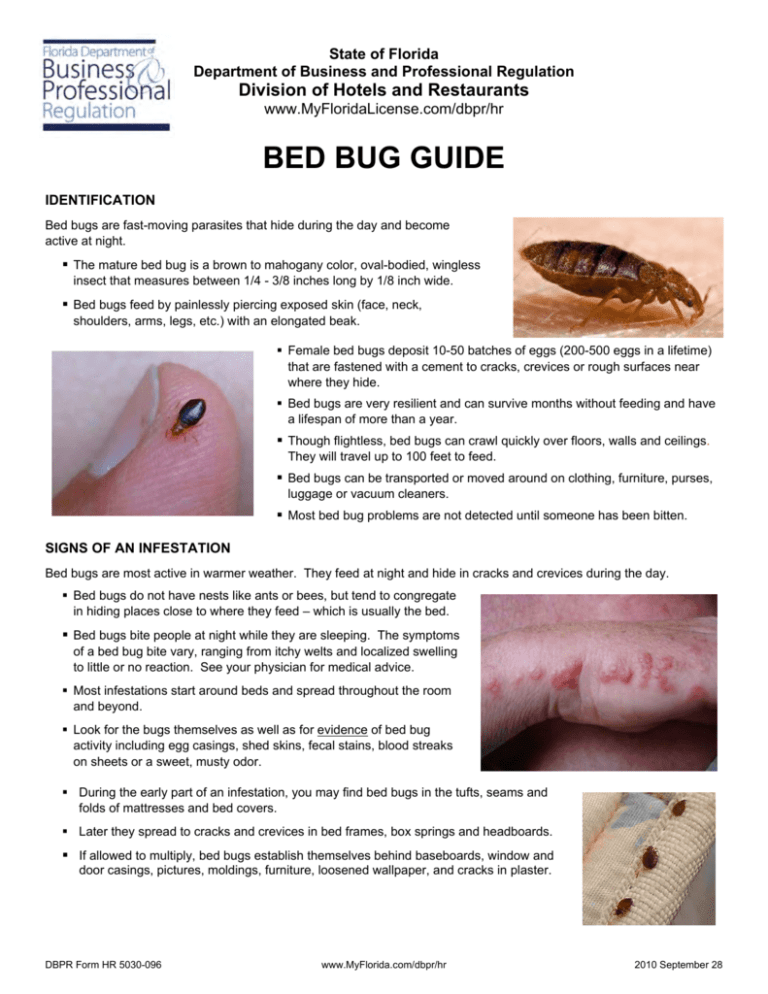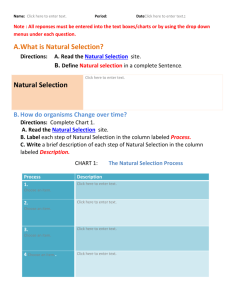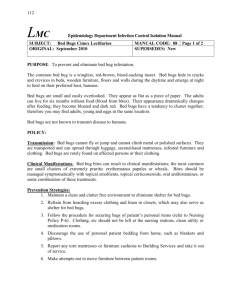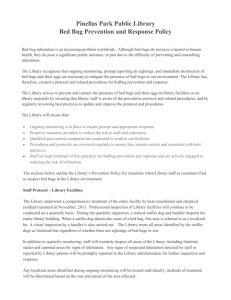bed bug guide - Department of Business and Professional Regulation
advertisement

State of Florida Department of Business and Professional Regulation Division of Hotels and Restaurants www.MyFloridaLicense.com/dbpr/hr BED BUG GUIDE IDENTIFICATION Bed bugs are fast-moving parasites that hide during the day and become active at night. The mature bed bug is a brown to mahogany color, oval-bodied, wingless insect that measures between 1/4 - 3/8 inches long by 1/8 inch wide. Bed bugs feed by painlessly piercing exposed skin (face, neck, shoulders, arms, legs, etc.) with an elongated beak. Female bed bugs deposit 10-50 batches of eggs (200-500 eggs in a lifetime) that are fastened with a cement to cracks, crevices or rough surfaces near where they hide. Bed bugs are very resilient and can survive months without feeding and have a lifespan of more than a year. Though flightless, bed bugs can crawl quickly over floors, walls and ceilings. They will travel up to 100 feet to feed. Bed bugs can be transported or moved around on clothing, furniture, purses, luggage or vacuum cleaners. Most bed bug problems are not detected until someone has been bitten. SIGNS OF AN INFESTATION Bed bugs are most active in warmer weather. They feed at night and hide in cracks and crevices during the day. Bed bugs do not have nests like ants or bees, but tend to congregate in hiding places close to where they feed – which is usually the bed. Bed bugs bite people at night while they are sleeping. The symptoms of a bed bug bite vary, ranging from itchy welts and localized swelling to little or no reaction. See your physician for medical advice. Most infestations start around beds and spread throughout the room and beyond. Look for the bugs themselves as well as for evidence of bed bug activity including egg casings, shed skins, fecal stains, blood streaks on sheets or a sweet, musty odor. During the early part of an infestation, you may find bed bugs in the tufts, seams and folds of mattresses and bed covers. Later they spread to cracks and crevices in bed frames, box springs and headboards. If allowed to multiply, bed bugs establish themselves behind baseboards, window and door casings, pictures, moldings, furniture, loosened wallpaper, and cracks in plaster. DBPR Form HR 5030-096 www.MyFlorida.com/dbpr/hr 2010 September 28 CONTROL OF BED BUGS Bed bugs are difficult to deal with and require the combined efforts of the property owner and/or tenant, as well as qualified pest control technicians. Preparation performed by tenant/owner includes: Launder clothes and linens on hot settings. Store in sealed plastic bags until chemical treatment is completed. Vacuum thoroughly, especially along carpet edges or replace carpet after completion of chemical treatment. Discard vacuum bag in a sealed plastic bag when vacuuming is completed. Remove and inspect all belongings from furniture, tables, wardrobes and closets. Dismantle bed and other furniture if possible. Discard mattresses and fabric furniture – especially if infestation is severe. Remove pictures and electrical outlet covers from walls and eliminate clutter. Chemical Treatment: Getting rid of these pests usually requires more than one treatment. The division highly recommends the use of a professional certified pest control company. Avoid using highly repellent formulations that cause bed bugs to scatter to many places. You may use dust formulations to treat wall voids and attics. Pest professionals recommend to repeat insecticide applications if bed bugs are present two weeks after the initial treatment. It is difficult to find all hiding places and hidden eggs may have hatched. Bed bugs have developed resistance to some insecticides. New Detection Methods: Dogs are available that have been specifically trained to find bed bugs – much more quickly than humans and almost 100% accurately. The costs of bed bug removal are substantially lower because the dogs can quickly pinpoint the location of bed bugs. Suitcase monitoring devices that employ the use of carbon dioxide as an attractant to detect the presence of bed bugs. Post treatment performed by tenant/owner includes: Wash and caulk cracks and crevices in walls, ceilings and floors. Paint walls and ceilings where paint is peeling or chipped and remove peeling wallpaper. Do not allow clutter to accumulate. MISCONCEPTIONS ABOUT BED BUGS Bed bugs are not the result of poor hygiene or poor housekeeping – bed bugs can affect anyone, anywhere, anytime. Bed bugs do not eat bait – bed bugs feed only on blood. Bed bugs are not transferred by sexual contact and do not transfer AIDS, herpes or scabies – bed bugs have not been associated with any disease transmission. Bed bugs do not live on their host – bed bugs feed on blood from their host, but do not live on the host. Bed bugs do not live in human hair and are not similar to body and pubic lice – bed bugs are not lice. For additional information please visit the Centers for Disease Control & Prevention’s website at http://www.dpd.cdc.gov/dpdx/HTML/Bedbugs.htm. DBPR Form HR 5030-096 www.MyFlorida.com/dbpr/hr 2010 September 28








